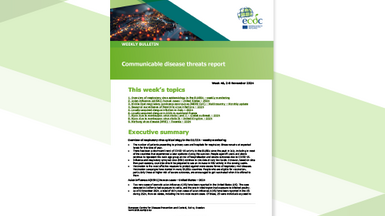West Nile virus risk assessment tool
West Nile virus (WNV) is an emerging pathogen whose ecology and epidemiology extend across multiple interfaces. As the epidemiology and transmission cycle of WNV is complex, assessing the risk of WNV being transmitted to humans is not always straightforward. Therefore, the WNV risk assessment tool has been developed to provide operational guidance in support of the risk assessment process. The tool specifically addresses two questions: definition of geographically affected areas and areas at risk of WNV transmission and the triggering of an alert for potential human WNV infection using indicators from different surveillance systems. The document is divided into three parts: key facts about WNV; description of surveillance systems used for WNV and the risk assessment tool.
Risk assessment is a continuous process and the WNV situation changes each year in Europe and will evolve further in the future. Therefore the risk assessment tool will also be regularly revised and updated in response to new evidence on the ecology of WNV in Europe as it emerges.
Executive Summary
How are geographically affected areas and areas at risk of West Nile virus (WNV) transmission defined?
When is an alert for potential human WNV infection triggered?
The WNV risk assessment tool provides operational guidance to assist the countries in determining the risk of human transmission of WNV on their territory. Using the information gathered through the surveillance mechanisms they can ascertain the level of risk within an area. Seven possible risk levels are defined. For each risk level, the tool outlines the questions to be answered and suggests obligatory and desirable surveillance activities, as well as public health response measures. In addition, the report offers key facts about WNV and description of surveillance systems used.
The epidemiology and transmission cycle of the WNV is complex and assessing the risk of WNV being transmitted to humans is not always straightforward. Risk assessment at local, national and EU level can help the timely implementation of preparedness activities, control measures, as well as provide information to decision makers
Download
Publication data
Tools for public health
West Nile virus risk assessment tool
The main objective of this tool is to assist countries in determining the risk of West Nile virus human transmission in their territory.






